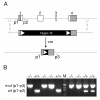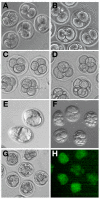Dppa3 / Pgc7 / stella is a maternal factor and is not required for germ cell specification in mice
- PMID: 15018652
- PMCID: PMC362866
- DOI: 10.1186/1471-213X-4-2
Dppa3 / Pgc7 / stella is a maternal factor and is not required for germ cell specification in mice
Abstract
Background: In mice, germ cells are specified through signalling between layers of cells comprising the primitive embryo. The function of Dppa3 (also known as Pgc7 or stella), a gene expressed in primordial germ cells at the time of their emergence in gastrulating embryos, is unknown, but a recent study has claimed that it plays a central role in germ cell specification.
Results: To test Dppa3's role in germ cell development, we disrupted the gene in mouse embryonic stem cells and generated mutant animals. We were able to obtain viable and fertile Dppa3-deficient animals of both sexes. Examination of embryonic and adult germ cells and gonads in Dppa3-deficient animals did not reveal any defects. However, most embryos derived from Dppa3-deficient oocytes failed to develop normally beyond the four-cell stage.
Conclusion: We found that Dppa3 is an important maternal factor in the cleavage stages of mouse embryogenesis. However, it is not required for germ cell specification.
Figures



Similar articles
-
A comprehensive, non-invasive visualization of primordial germ cell development in mice by the Prdm1-mVenus and Dppa3-ECFP double transgenic reporter.Reproduction. 2008 Oct;136(4):503-14. doi: 10.1530/REP-08-0053. Epub 2008 Jun 26. Reproduction. 2008. PMID: 18583473
-
Mechanisms of germ-cell specification in mouse embryos.Bioessays. 2005 Feb;27(2):136-43. doi: 10.1002/bies.20178. Bioessays. 2005. PMID: 15666347 Review.
-
Germ cells: sex and repression in mice.Curr Biol. 2005 Aug 9;15(15):R600-3. doi: 10.1016/j.cub.2005.07.043. Curr Biol. 2005. PMID: 16085483 Review.
-
GATA-like protein-1 (GLP-1) is required for normal germ cell development during embryonic oogenesis.Reproduction. 2011 Feb;141(2):173-81. doi: 10.1530/REP-10-0376. Epub 2010 Dec 1. Reproduction. 2011. PMID: 21123517
-
PU.1 (Sfpi1), a pleiotropic regulator expressed from the first embryonic stages with a crucial function in germinal progenitors.Development. 2007 Nov;134(21):3815-25. doi: 10.1242/dev.003467. Epub 2007 Oct 3. Development. 2007. PMID: 17913791
Cited by
-
Matrix remodeling maintains embryonic stem cell self-renewal by activating Stat3.Stem Cells. 2013 Jun;31(6):1097-106. doi: 10.1002/stem.1360. Stem Cells. 2013. PMID: 23404867 Free PMC article.
-
Widespread but tissue-specific patterns of interferon-induced transmembrane protein 3 (IFITM3, FRAGILIS, MIL-1) in the mouse gastrula.Gene Expr Patterns. 2013 Oct;13(7):225-39. doi: 10.1016/j.gep.2013.04.003. Epub 2013 Apr 29. Gene Expr Patterns. 2013. PMID: 23639725 Free PMC article.
-
Nlrp2, a maternal effect gene required for early embryonic development in the mouse.PLoS One. 2012;7(1):e30344. doi: 10.1371/journal.pone.0030344. Epub 2012 Jan 25. PLoS One. 2012. PMID: 22295082 Free PMC article.
-
Intercellular bridges coordinate the transition from pluripotency to meiosis in mouse fetal oocytes.Sci Adv. 2021 Apr 7;7(15):eabc6747. doi: 10.1126/sciadv.abc6747. Print 2021 Apr. Sci Adv. 2021. PMID: 33827806 Free PMC article.
-
Stella protein facilitates DNA demethylation by disrupting the chromatin association of the RING finger-type E3 ubiquitin ligase UHRF1.J Biol Chem. 2019 May 31;294(22):8907-8917. doi: 10.1074/jbc.RA119.008008. Epub 2019 Apr 24. J Biol Chem. 2019. PMID: 31018966 Free PMC article.
References
Publication types
MeSH terms
Substances
LinkOut - more resources
Full Text Sources
Other Literature Sources
Molecular Biology Databases

